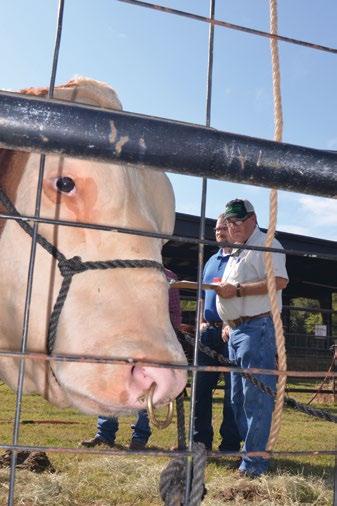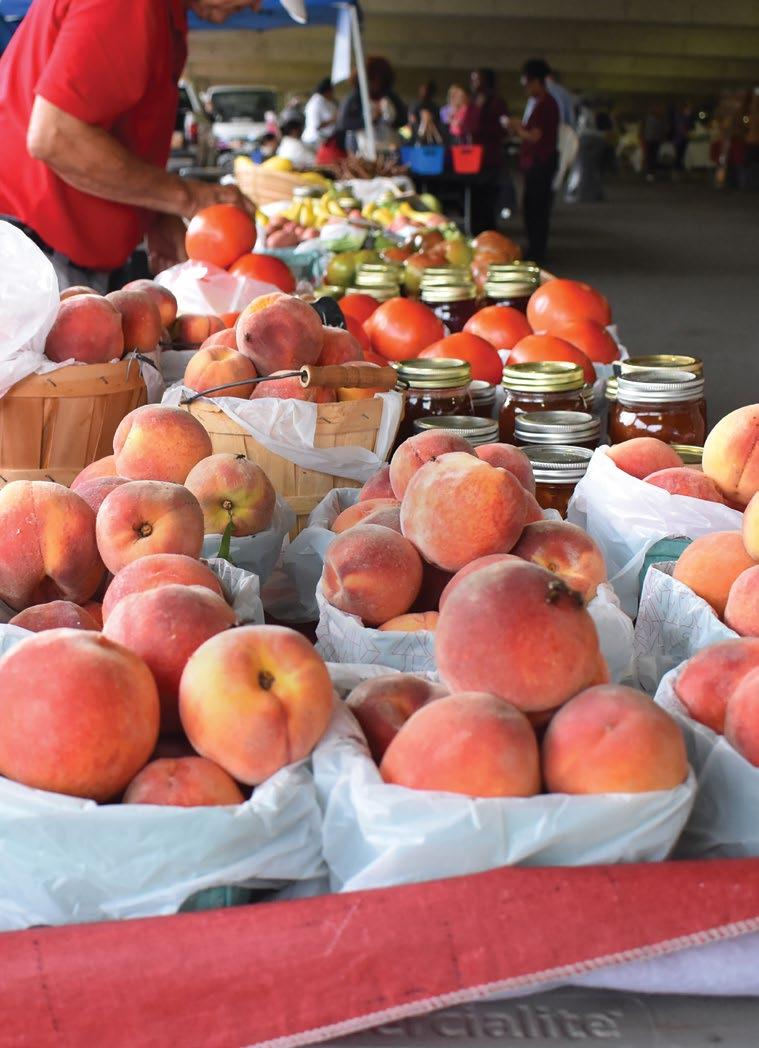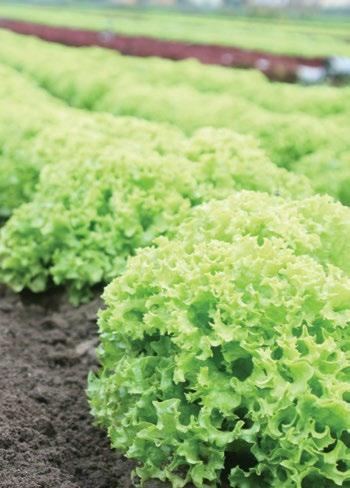
10 minute read
Livestock Inspectors are Essential for Protection
from Arkansas Grown
Inspectors Monitor for Disease and Contaminated Food
Arkansas’s multi-pronged defense against animal diseases and food safety risks happens at least 1,500 times a year at livestock markets across the state with the Arkansas Department of Agriculture’s Livestock and Poultry Division inspectors.
Advertisement
“Livestock and Poultry Division inspectors are the primary watchdogs at livestock markets for any kind of diseases or other potential dangers, such as agriterrorism,” said Blake Walters with the Arkansas Department of Agriculture’s Livestock and Poultry Division.
Walters supervises 31 inspectors, each of them assigned to attend and monitor the weekly livestock sales that take place across the state. The inspectors are trained to detect signs of disease in livestock and to identify potential warning signs of any risk to the food supply.
Kenneth Riggins of Osage, who has been a livestock inspector for 42 years, said inspectors don’t have the same kind of adversarial relationship that other government regulators may have within their industry. That’s because Arkansas’s ranchers recognize the importance of an inspector’s work.
“Our main focus is disease control. Some of these diseases would cost producers a lot of money if we didn’t control it,” Riggins said. “99% of people want us there because they know we’re there to help them. Without our help, Arkansas cattle could not leave the state.”
Walters said there are 26 livestock markets in the state, most of which conduct sales at least once a week. Inspectors arrive at a sale early and don’t leave until it’s over. During the sale, the inspector is visually monitoring the animals for signs of illness.
Like Riggins, Walters emphasized that surveillance is a pivotal role of inspectors at a livestock market.
“We’re looking for symptoms of disease, and if any animal shows signs of foreign animal diseases (FADs), it is going to be pulled aside. We’re going to immediately start working on finding out where it came from,” Walters said.
Inspectors apply ear tags to every animal that comes into the sale barn that is 18 months or older. The ear tag information is logged into a federal database so that the animal is easily traceable in the event it contracts a disease or is exposed to diseases. If an animal enters a sale barn and has already been tagged, inspectors record the tag information and verify that the entry requirements are met.
“Our mission here is to protect animal and human health,” Walters said. “Traceability is a huge portion of what we’re working on, so that you’re able to trace back where your food came from. If any animal ends up sick, that animal can be traced back to where it’s been and what it’s been in contact with.”
When not tagging animals or conducting surveillance for signs of disease at a market, Riggins said he’s reviewing paperwork for accuracy and making sure animals have received the correct types of immunizations and testing. Inspectors offer voluntary vaccinations, provide emergency response duties, and test swine herds and poultry flocks annually for certain diseases and during any avian influenza outbreaks.
Fair season is a particularly busy time for Livestock and Poultry Division inspectors who annually provide approximately 2,400 manhours at 77 fairs across the state. They are responsible for monitoring the state fair and district and county fairs for livestock diseases by checking the health papers of every animal that enters the fairgrounds and conducting visual inspections. Inspectors also perform annual audits of fairs that receive funding from the state.
“We’re at fairs to keep an animal from going home with something they didn’t come with,” Walters said.

The Livestock and Poultry Division makes training for the inspectors a priority.

What is the Produce Safety Rule?
Important Guidelines that Protect Consumers from Foodborne Illnesses
Every year millions of people contract foodborne illnesses in the United States. The Food Safety Modernization Act (FSMA) was developed by the U.S. Food and Drug Administration (FDA) in an effort to standardize best practices for food safety, and to combat the public health impact of these foodborne pathogens. The FSMA, a branch of the Food, Drug and Cosmetic Act, consists of seven rules. The intent of the FSMA is to protect the U.S. food supply during all points of the supply and distribution chains. These rules are a science and risk-based (preventive) approach to the management of food safety, which is a major shift from the government’s past strategy of reacting to an outbreak after it happens.
The Standards for the Growing, Harvesting, Packing, and Holding of Produce for Human Consumption, otherwise known as the Produce Safety Rule, is the first set of on-farm Federal food safety requirements for produce. It affects farms with annual produce sales of $25,000 or more that grow and sell produce that is typically consumed raw. The FSMA was signed into law in January of 2011, and the final Produce Safety Rule went into effect January 26, 2016. However, farmers have time to come into compliance based on farm income. The first tier of farms to come into compliance are the large farms, selling over $500,000 in produce, with a compliance date of January 26, 2018. Large produce farms are the first cohort to be inspected under the Rule beginning in 2019.
“Walking farmers through the FSMA Produce Safety Rule through training and technical assistance, visiting farms to see practices in place, and making recommendations for improvement helps farmers understand the “why” behind the regulations. When we understand the why, the how is easy,” explains Dr. Amanda Philyaw Perez, assistant professor and extension food systems and safety specialist with University of Arkansas Cooperative Extension Service (UACES).
How does the PSR apply to produce farms?
Coverage. The FSMA Produce Safety Rule (PSR) establishes agricultural production standards for personnel qualifications and training, health and hygiene, agricultural water, use of biological soil amendments of animal origin, intrusion of wild and domesticated animals, and sanitation of equipment, tools, and buildings. It will affect produce businesses and operations at different times, depending on farm income. Produce farms affected by the Rule are divided into three tiers: above $500,000 in gross annual produce sales (large farms), $250,000 to $500,000 in gross annual sales (small farms), or $25,000 to $250,000 in gross annual sales (very small farms). These numbers are to be based on the farm’s previous three-year average and are adjusted for inflation annually. Farmers who need help understanding their status in relation to the regulations should contact the Arkansas Department of Agriculture.
Exemptions and Exclusions. A grower could potentially meet the requirements to be excluded, qualified exempt, or commercial-processing exempt. The PSR includes an exclusion for extremely small produce farms that sell less than $25,000* in produce annually. To be eligible for a qualified exemption, the farm must meet two requirements: the farm must have food sales averaging less than $500,000* per year during the previous three years; and the farm’s sales to qualified end-users must exceed sales to all others combined during the previous three years. Food is defined as articles used for food or drink for human or animals (i.e. cattle, hay, dairy, feed, produce, all other crops and value-added products). Those farms that achieve a qualified exemption status must follow certain modified requirements. There are also exemptions for rarely consumed raw produce, food grains, produce that is used for personal or onfarm consumption, or produce that receives a verified
commercial processing technique. This part of the Rule can be very perplexing; growers who need more clarity can contact either the Department, or the UACES for more detailed information.
*Adjust values for inflation annually. These values can be found at www.fda.gov/food/food-safetymodernization-act-fsma/fsma-inflation-adjustedcut-offs
Audit vs Inspection. Third-party audits may come into question for some growers: how do they apply, and can they serve as a substitute for a FSMA PSR inspection? Beginning in 1998, Good Agricultural Practices (GAPs) were developed by the FDA as voluntary produce safety guidelines. At that time, third-party organizations also began offering audit services from the development of their own standards; these include PrimusGFS, Global GAP, and others. This initiated food companies to develop the Global Food Safety Initiative (GFSI) in 2000 which set the bar for audit standards. The USDA also implemented the GAP audit verification program alongside the initial development of these thirdparty auditing schemes. These audits are industryled, market driven standards that were voluntarily adopted by growers to satisfy buyers. While PSR compliance and third-party audits share many of the same principals, they are not equivalent. The PSR is a federally mandated program with which affected growers are required to understand, adopt new practices beyond the third-party audit, and comply. It is not voluntary, and it is the growers’ responsibility to learn about the differences in the third-party audit and FSMA requirements. Still, growers who have experience with third-party audits may be better prepared for compliance within the FSMA PSR regulations.

Produce Safety in Arkansas

While the PSR is a federally mandated law, the FDA is working with the states for the implementation of the rule. The FDA believes that developing a working relationship with states is of great significance because of their ability to better understand farming practices that occur within their state lines; state
departments of agriculture and university landgrant extension services have a historically close relationship with farms. To better coordinate with states, the FDA established the State Produce Implementation Cooperative Agreement Program (CAP) to provide funds for a variety of activities like education, training, and technical assistance to produce farms.
Regulation. The Department was awarded a five-year CAP grant in 2016. It was classified as a Competition A/B program, meaning it receives funding for infrastructure, education, technical assistance, and inventory program components, as well as an inspection, compliance, and enforcement program. The Department produce safety team focuses on the regulatory aspects of the PSR. The program conducts all initial and routine produce safety inspections for the state of Arkansas. The national PSR motto is to: “educate before, and while, we regulate.” This philosophy holds true for the Department Produce Safety Program.
Education and Outreach. The Department has one CAP subaward in place with the University of Arkansas System Division of Agriculture Cooperative Extension Service to assist with education and outreach activities. It hosts Produce Safety Alliance Grower Trainings throughout the state. This is a standardized national produce safety training program to prepare fresh produce growers to meet the regulatory requirements in the PSR. The trainings are typically a one-day, 8-hour course, and 18 have been completed to date. Occasionally, UA Extension will host a two-day workshop series with the first day being the PSA Grower Training, and the second day being a supplemental course. The Department also provides one-on-one consultations, technical assistance to address specific food safety issues, and On-Farm Readiness Reviews (OFRRs) for growers. An OFRR is a free, on-farm assessment designed to help growers feel prepared and ready for a regulatory inspection. It is completely voluntary on the growers’ part and is scheduled for their convenience. To find out more, or to determine whether you’re subject to the Rule, please contact the Arkansas Produce Safety Team at food.safety@agriculture. arkansas.gov or visit one of the following:
www.uaex.edu/producesafety
agriculture.arkansas.gov/produce-safety-program
Department Produce Safety Contacts:
John Lansdale Agriculture Program Manager (870) 820-6787 john.lansdale@agriculture.arkansas.gov
UACES Produce Safety Contacts:
Dr. Amanda Philyaw Perez Assistant Professor Extension Specialist- Food Systems & Food Safety (501) 671-2228 aperez@uaex.edu
*Funding for this statement, publication, press release, etc., was made possible, in part, by the Food and Drug Administration through grant number U18FD005918. The views expressed in written materials or publications and by speakers and moderators do not necessarily reflect the official policies of the Food and Drug Administration; nor does any mention of trade names, commercial practices, or organization imply endorsement by the United States Government.










